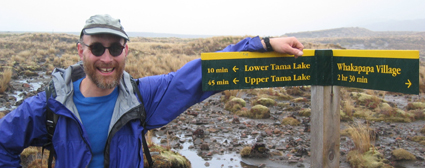 Paul
Bierman of the University of Vermont in Burlington, shown here in New Zealand,
received the National Science Foundation Director’s Distinguished Teaching
Scholars award this summer, and will receive $300,000 over four years to fund
his Landscape Change Program. Courtesy of Paul Bierman.
Paul
Bierman of the University of Vermont in Burlington, shown here in New Zealand,
received the National Science Foundation Director’s Distinguished Teaching
Scholars award this summer, and will receive $300,000 over four years to fund
his Landscape Change Program. Courtesy of Paul Bierman.This summer, Bierman, now a 43-year-old geology professor, received the National Science Foundation (NSF) Director’s Distinguished Teaching Scholars award for his research, and his work as a teacher at the University of Vermont in Burlington.
As one of eight geoscience faculty in a department that offers undergraduate and master’s degrees in geology (and where his wife Christine Massey, a science educator, also works), Bierman specializes in cosmogenic nuclides — isotopes formed in rocks through interaction with cosmic rays. He has also been pursuing another love: the Landscape Change Program, funded by NSF. The online program archives photographs of Vermont from the 1800s to the present, images useful for comparing how the state’s forests and landforms have shifted over the passing decades.
Bierman uses the landscape images to get students of all ages excited about the local geology, says Kyle Nichols, a former graduate student who now uses Bierman’s teaching methods as a geology professor at Skidmore College in Saratoga Springs, N.Y. Nichols says that the landscape idea started during Bierman’s preparation for a presentation in 1998 on landslides and slope instability. He scanned stereographs (paired photos that produce a 3-D image) from the 1800s, from the University of Vermont’s special collections. Taken over time, the images showed “expansive clearcuts in the background, and landslides that happened with that clearcutting,” Nichols says.
Although such techniques are not new to the research community, the Landscape Change Program has brought interactions between landscapes and humans to new eyes, from K-12 students to Vermont community members. Such informal and interactive approaches, including those he first picked up at the Boston Museum of Science overnight program, are central to Bierman’s teaching.
“You can use some pretty whacky methods to get your point across,” Bierman says. In his natural hazards survey course for 200 undergraduates, for example, Bierman’s teaching assistants bring a sheet cake into the lecture hall for the impacts talk. Using a slingshot to launch everything from marbles to apples, students in the class bombard the cake, as an asteroid or comet might hit Earth. Nichols recalls one successful year with a softball: “It was messy,” he says, and those students probably never will forget “the transfer of energy from softball to sheet cake” (which they ate afterward).
“I’m trying to teach 200 kids like there are 10 kids in the room,” Bierman says. While teaching nonmajor students, he says, “I want them to come out and say ‘science is cool,’” and to learn a little about how scientists think.
Bierman himself did not discover geology until he went to Williams College in Williamstown, Mass. Growing up in Baltimore, Md., he spent time on the beach, fascinated with erosion, leading his mother to think he’d become a geologist. He turned to chemistry at Williams, but as a freshman, Bierman slipped into an advanced course on structural geology and fell in love, switching to major in geology. During his junior year at Williams’ Maritime Studies Program at Mystic Seaport, Conn., the faculty mixed ocean science and policy in an “incredible integrating experience” that “shaped my career,” Bierman says. After weeks in the field the following summer studying structures, and one week spent mapping glacial deposits at the Montana State field camp, Bierman was again hooked on landforms, but also questioning whether he wanted to pursue geology forever.
Bierman’s advisor at Williams, David Dethier, recalls that he considered medical school for awhile. Instead of deciding right away, Bierman took off what would have been his senior year, working on restoring a steamboat on Moosehead Lake in Maine while teaching in a kindergarten through sixth grade educational program. Dethier says that Bierman was always interested in “communicating geoscience to the people who should hear about it and learn about it, be they undergraduate or graduate students, town officials or whatever.” After graduating, for example, Bierman consulted with Williamstown officials for a study of possible contamination of the town’s water table from nearby dumps. He eventually went on to graduate work at the University of Washington in Seattle.
“I’m driven to do things well,” Bierman says, and “I love what I do — landscape history literally gets me out of bed at 5 a.m.”
“I don’t think Paul sleeps, actually,” says Lyman Persico, a former student of Bierman’s at the University of Vermont. “If you are willing to work hard, he’s willing to help you succeed,” says Persico, who is now a graduate student at the University of New Mexico and just co-authored a paper with Bierman. “His excitement in the field just brings everyone else into what he’s doing.”
Naomi Lubick

